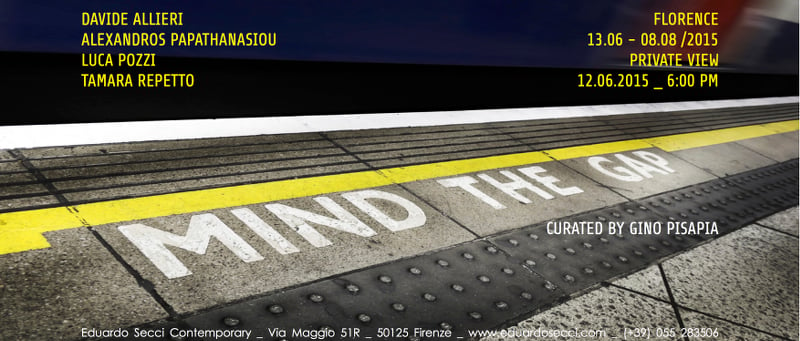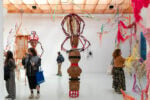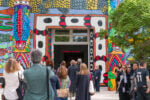Mind the Gap

“Mind the gap”, tecnicamente tradotta in “Attenzione al vuoto”, intende allertare i viaggiatori spesso distratti rispetto a quello che potrebbe essere il pericolo costituito dallo spazio che intercorre tra la banchina ferroviaria e il pianale del treno. L’idea progettuale nasce dunque dall’esigenza di concentrarsi su quel “vuoto” evidenziato da “Mind the gap”, accendendo i riflettori della conoscenza acquisita e acquisibile attraverso l’esperienza.
Comunicato stampa
La galleria Eduardo Secci Contemporary è lieta di inaugurare venerdì 12 giugno 2015 alle ore 18.00, negli spazi fiorentini di Via Maggio 51R la mostra collettiva dal titolo Mind the Gap a cura di Gino Pisapia.
La scrittura espositiva si propone di creare attraverso le opere di Davide Allieri (Bergamo, 1982), Alexandros Papathanasiou (Swansea, 1977), Luca Pozzi (Milano,1983) e Tamara Repetto (Genova, 1973), un percorso eterogeneo e coerente, capace di restituire a chi guarda una completa e complessa geografia del sistema di relazioni e condivisioni che le opere, in maniera solidale e aperta con lo spazio, attuano.
Il titolo della mostra è preso direttamente in prestito dalla nota registrazione “Mind the gap”, introdotta per la prima volta nel 1969 nella Metropolitana di Londra e da allora seppur con piccole varianti si è diffusa su scala internazionale entrando a far parte della colonna sonora “obbligata”, che accompagna il transito quotidiano di milioni di utenti nel mondo.
“Mind the gap”, tecnicamente tradotta in “Attenzione al vuoto”, intende allertare i viaggiatori spesso distratti rispetto a quello che potrebbe essere il pericolo costituito dallo spazio che intercorre tra la banchina ferroviaria e il pianale del treno.
L’idea progettuale nasce dunque dall’esigenza di concentrarsi su quel “vuoto” evidenziato da “Mind the gap”, accendendo i riflettori della conoscenza acquisita e acquisibile attraverso l’esperienza.
Esperienza diretta e indiretta, attiva e passiva, che consente di provare a capire attraverso la forma, le numerose modalità che il vuoto ha di manifestarsi o semplicemente di agire, accogliendo i fenomeni che in esso si generano dando vita a costruzioni percepibili non solo alla vista ma anche all’udito e all’olfatto.
Possiamo perciò affermare che alla base delle attività che accompagnano i processi formativi delle opere e che interessano la fruizione estetica delle forme da esse prodotte, non sta una teoria del vuoto, ma un’esperienza del vuoto, che è ottenibile solo mediante la pratica.
Gli artisti coinvolti nel progetto portano al cuore delle loro poetiche un’indagine complessa che declina concetti e forme seguendo una pluralità metodologica capace di far collimare il detto con il non detto, il vuoto con il pieno in una funzione reversibile e continua.
Qui l’indagine sul racconto artistico contemporaneo si carica di una corposa mole di riferimenti, suggestioni e ispirazioni, arricchendosi al contempo della storia e dei suoi “prodotti”, delle scoperte e delle regole che il progresso costantemente ci consegna.
La mostra si apre con una serie di opere che analizzano il tema del vuoto su più livelli e riunisce due immagini fotografiche tratte dal macro progetto Supersymmetric Partner di Luca Pozzi, rispettivamente del 2010 e 2014, dove l’artista si lascia ritrarre davanti ai banchetti del Veronese mentre compie un gesto atletico, spiccando un salto fino a collocarsi idealmente nel vuoto creato tra i personaggi dipinti con l’intento di unificare lo spazio e il tempo, la storia passata e quella futura attraverso la gravità che colma il vuoto nel presente, mediante la massa corporea dell’artista stesso, quindi con la sua immagine.
Oppure il feltro Still waiting for a spatial concept II, 2015, ispirato al Concetto Spaziale, Attese, del 1965, formato da 12 tagli, che Alexandros Papathanasiou in maniera consapevolmente lucida e ironica ricuce, chiudendo definitivamente quello spazio vuoto reale aperto 50 anni prima dalla geniale intuizione di Fontana.
In mostra sempre di Papathanasiou viene presentato Into Dust, 2014, scultura in progress, di forma sferica realizzata completamente di polvere, quella stessa che si muove libera nel vuoto e impossibile da percepire se non attraverso la sua stratificazione nel tempo.
A questo punto il racconto espositivo prosegue con due sculture di Davide Allieri, 0.488 cubic meters (K), 2015 e Senza Titolo, 2013, differenti tipologie di “teche” molto curate nei dettagli, eleganti, progettate come architetture e completamente vuote.
Se la prima palesa nel titolo il calcolo del suo volume interno, “conservando” il vuoto, la seconda privata dei vetri ne viene attraversata.
Completa la mostra l’installazione ambientale di Tamara Repetto che in un certo qual modo concentra e sintetizza le differenti proprietà del vuoto.
Oniria, 2014, è un’opera esperienziale, che vive nel vuoto, azionata da un rilevatore di movimento che al passaggio del pubblico attiva un circuito virtuoso capace di produrre suoni e profumi.
Ufficio Stampa
Ottavia Sartini
Eduardo Secci Contemporary is proud to announce the vernissage of the group showing entitled Mind the Gap, curated by Gino Pisapia, on 12 June 2015 at 7:00 PM at the Florentine exhibition spa- ce in Via Maggio 51R.
Through the works of Davide Allieri (Bergamo, 1982), Alexandros Papathanasiou (Swansea, 1977), Luca Pozzi (Milan, 1983) and Tamara Repetto (Genoa, 1973), the exhibition script proposes a recre- ation of a heterogeneous yet cohesive itinerary capable of presenting the viewer with a complete view of the complex geography of the system of relationships and interplays which the works, when taken together, bring into being as they interact openly with the space.
The exhibition title is borrowed directly from the well-known recorded announcement ‘Mind the Gap', which was first introduced in 1969 on the London Underground and since then, albeit with slight variations, has spread internationally and become part of the ‘compulsory' soundtrack ac- companying the daily transit of millions of train users throughout the world.
The phrase ‘Mind the Gap' alerts (often harried) train users to the risk of injury from stepping into the empty space (the gap or void) between the station platform and the train floor.
This said, the project idea arose from consideration of the need to concentrate on that ‘void' brou- ght to our attention by the phrase ‘Mind the Gap', spotlighting knowledge acquired, and which can be acquired, through experience.
Direct and indirect experience, active and passive; experience which permits understanding, throu- gh form, of the many ways in which the ‘gap' can manifest or simply act, pulling in the phenomena generated within it, giving life to constructions which are perceptible not only by sight but through hearing and smell as well.
We can therefore say that at the base of the activities which accompany the processes which form the works and those which have to do with aesthetic appreciation of the forms produced by the processes, there is not a theory of emptiness but an experience of the void – obtainable only through direct participation.
The artists involved in the project carry into the hearts of their poetics a complex enquiry which is capable of filling the said with the unsaid, the empty with the full; of continually rewriting a reversible function.
Here, the investigation of contemporary story-telling in art acquires a strong charge made of refe- rences, suggestions and inspirations and at the same time is enriched by history and its products, the discoveries, the rules constantly handed down to us by progress.
The exhibition opens with a series of works which analyse the theme of the ‘gap' at several levels and musters two photographic images from the Supersymmetric Partner macro-project by Luca Pozzi, from 2010 and 2014, in which the artist is captured in front of Veronese's banquet scenes while he is engaged in an athletic feat, jumping to (ideally) land in an empty space or ‘gap' between one and another of the painted characters, with the intent of unifying space and time, past history and the future, using that gravity which fills the void in the present with the mass of the artist's body, and thus with his image.
Or the work in felt, entitled Stillwaiting for a spatialconcept II, 2015, inspired by Concetto Spaziale, Attese (1965) with its 12 cuts which Alexandros Papathanasiou sews up, with mindful lucidity and irony, to definitively close a real empty space opened 50 years ago by Fontana's genial intuition. Also by Papathanasiou, the exhibition presents IntoDust, 2014, an sculpture-in-progress, spherical in form, made entirely of dust – the same dust which moves freely through the void and is therefore impossible to perceive except as it stratifies over time.
Turning a page in the script, the exhibition continues with two sculptures by Davide Allieri, 0.488 cu- bicmeters (K), 2015, and Senza Titolo, 2013: different types of ‘display cases', constructed with great attention to detail, elegant, designed as architectures – and totally empty.
While the former candidly states the calculation of its interior volume in the title, ‘preserving' the void, the second, with no glass, is invaded, pierced by it.
Last at the exhibition is the environmental installation by Tamara Repetto, which to a degree con- centrates and synthesises the different properties of the void.
Oniria, 2014, is an existential work which inhabits the gap, actuated by a motion sensor which, only when the public passes, activates a virtuous circuit capable of producing sounds and scents.
The catalogue, published by Eduardo SecciContemporary with photographic layouts and critical texts by the exhibition curator, analyses and develops the theme addressed by the exhibition. The catalogue will be presented on occasion of the finissage.



